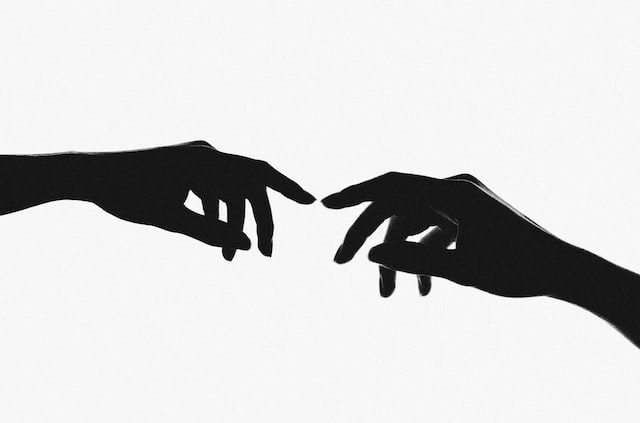
One of my greatest struggles with relating to another is knowing when, where, and how to present authentic feedback or ask genuine questions. An authentic connection requires an ultimate vulnerability—meaning we are open to the possibility of wounding, and these wounds can cause pain to us or the Other.
We don’t like pain, though, do we? We created conditions around our entire existence to protect us from or altogether prevent pain. When we enter any kind of mutual relation, however, we must open ourselves up to the possibility of bruising and bleeding—mentally, of course.
With any genuine connection, we must be honest—be real— with the Other. But we are often still learning about a person, so things that generally activate reflective or critical thinking we disregard. We are more focused on the things we like about this person.
After we begin developing an idealized picture of this person, and after the limerence wears off, we question ourselves for wanting to challenge our friends. We start perceiving a different image of that person.
Limerence is what Psychologist Dorothy Tennov calls “an involuntary potentially inspiring state of adoration and attachment to a limerent object (LO) involving intrusive and obsessive thoughts, feelings and behaviors from euphoria to despair, contingent on perceived emotional reciprocation.” (Willmott, Lynn (2012). Love and Limerence)
It’s a term typically reserved for romantic love, but, from my view, limerence aptly describes that initial high we all get when we meet and connect with someone for the first time. Some of the critical components of limerence reflect parts of an authentic connection within a friendship. Here are a few elements that I believe resonate with non-romantic relationships.
- Acute longing for reciprocation
- Dependency of mood on the LO’s action
- Fear of rejection
- Intensification through adversity
- An aching of the heart when uncertainty is strong
- Buoyancy (walking on air) when reciprocation seems evident
- Intensity of feeling that leaves other concerns in the background
- Remarkable ability to emphasize what is admirable in the LO and avoid dwelling on the negative
Limerence is a quiet attachment of an established relationship. It’s more than an infatuation. It’s also more than a lustful desire. I would categorize it as an erotic component that draws us to the attention of others. Limerence is an erotic phenomenon that captivates us and creates within us a desire to share space with this person. A space between idealization and transaction or objectification. Dr. Jack Morin articulates the distinction in his best-selling book, The Erotic Mind: Unlocking the Inner Sources of Sexual Passion and Fulfillment.
Where lust objectifies, limerence idealizes. When you idealize someone, in a sense, you’re engaging in an ultra-personal act of appreciation. Ironically, however, idealization can simply be another form of objectification. If someone has fallen in love with you (especially a stranger or casual acquaintance) and you didn’t reciprocate, you probably felt very much like an object—a blank screen upon which the person was projecting a private fantasy. And you probably wondered if the real you mattered at all. Limerence produces a special type of perceptual distortion in which your attention is focused on all that is attractive and desirable about the LO and blots out the negative traits or transforms them into endearing signs of the beloved’s uniqueness. Those under the spell of early romance are notoriously unable to see the faults of the beloved, even if they are glaring to everyone else—particularly concerned friends and family members. (59)
There is no question that within romantic relationships, limerence is an emotional intensity that makes itself known and felt, 99% of the time. My question is, how often does limerence play a part in the build-up and ultimate demise of a friendship? Not only that, but does the liquidation of limerence result in conflict? Is there a way to replenish limerence?
Conflicts inevitably occur in most relationships. From my own experience, conflict is what strengthens authentic connections. Conflict brings us face to face with change. As my friend often says, “You can’t grow without opposition or resistance.”
However, as limerence wears off, we begin to see things differently. We start to notice that more pieces of the puzzle are revealing an image that we hadn’t expected. The “perpetual distortion” can no longer be transformed “into endearing signs of the beloved’s uniqueness.” Depending on what kind of relationship we had idealized, seeing the “flaws and all” of a person could make us think twice about continuing a connection.
Most people don’t bear it all right away in any relationship. We hesitate to bring our skeletons to coffee or lunch when we are just getting to know another person. That doesn’t mean all people hold back, however. I make it a point to let my skeletons out of the closet when I first get to know someone. I do this to show others that they can trust me with their secrets. I want them to know that I have lived an imperfect life and that I have no expectations of perfectionism from them. I want them to see me naked.
Not everyone can offer that much of themselves right away. The fear of being over-exposed is to be understood. When we reveal too much of ourselves, it can be used against us later as a deficit to our character should conflict arise. It could change the other’s perception of us if it were known that we had a criminal record, had an abortion, or stopped going to church. For many, that is just too much vulnerability in the beginning.
Like romantic relationships, the perceptual distortion of limerence within friendships operates in a few ways. First, this fading away from what initially swept us away produces feelings of anger or even betrayal. We can feel like we didn’t even know that person upon a new discovery. But that says more about our idealized projections than anything else. It demonstrates that we might have fantasized a depiction of the Other that was too far from reality.
However, limerence also offers a distortion that can “help create a framework for the genuine appreciation that marks the most fulfilling long-term…bonds.” (Morin, 61) From my view, this phase of limerence most resembles the grace of God. We see Other as we want God to see us—untarnished, imperfectly perfect, and placed on a pedestal soaring above us.
Limerence is the distorter. But with all things, if our distortion of the Other isn’t backed by love—if our infatuation with another, even within a mutually relating friendship, is rooted in selfish gain or set up as merely a transaction for self-gratification; destruction can and will ensue.
Relationships synthesize love and power to create what Dr. Morin calls the “urge to merge.” He notes that it “appears to be universal in limerence.” This idea of merging is “intrinsically interwoven with surrender and control… Without surrender, there is no merging. To bask in the transformative powers of the idealized other, you must relinquish control.” (63)
Inevitably, and similarly to how we are with our lovers, we begin to feel the need to control our friend. We want to fold them into our own lives. We slowly discover ways we can sway them to conform to our ideas so that we can take comfort in our relationship.
We soon forget that all relationships are about an unfolding, not a folding in. When we try to fold someone into our relationship, we are trying to make them more like us, more convenient to us, more beneficial to us. The reality is that a relationship is supposed to unfold who we are as a whole person, to unfold our thoughts and ideas to reveal more, not less. I can only discover more about myself so long as I continue to discover more about others.
Psychoanalyst Ethel Person asserts that the search for love has “the ultimate goal” of “enlargement of the self.” It seems to me that any form of mutual relationship that we hold as valuable should also add to the wholeness of who we are. But sometimes we twist that up a bit and we want to enlarge ourselves by making others just like us. This doesn’t enlarge the Self, it enlarges the ego.
Do you try to turn down the volume of your loud friends? Have you ever tried to cover up the friends that are too revealing? Do you find yourself thinking, “If I could help soften up her edges, she could be this, or do that”? Have you ever caught yourself trying to liberalize a conservative friend or sway a friend who is a Democrat to vote Republican? Have you ever heard yourself justify these actions by referring to that classic cliché: “I’m just trying to help you be the best you”?
What we are actually doing is trying to pull the best version of “me” out of our friend. And when we make it about us and not them, we are doing a great disservice to our potential growth, their potential growth, and we are harming the connection.
In our initial attraction to another, we are magnetized not only by what we find agreeable but also the things that differ from us. Confusing right? Agreeability is seductive and alluring but opposites attract. It’s a rather complex dynamic that creates the surge of limerence to begin with.
For instance, an overriding power of attraction draws you toward a loud and rather a blunt provocateur. She exhibits behaviors that you would never feel confident enough to act out. There is something both agreeable and disagreeable in her behavior and attitude that draws you in. This example echoes what Psychoanalyst Theodore Reik proposed as the motivational urge to search for the idealized self. He claims that “all love is founded on dissatisfaction with oneself.” He said, “Tell me whom you love and I will tell you who you are and, more especially, who you want to be.” (On love and lust: On the psychoanalysis of romantic and sexual emotions, 190,96)
What he points out is that that which “draws us magnetically toward that special other is really just a fascination with our own unattainable perfection.” (Morin, 58)
Could Person and Reik both be right? It is with and through relations with others that we seek to both enlarge Self and search for Self. We can only expand our own existence by the experience of others, and we can only know ourselves and develop ourselves with the shared experiences from others.
It is only because Other exists that I can identify myself as “me” and Other as “you.” Without “you” there is no “me.”
So, what happens when we try to make “you” “me”? The same thing that happens in romantic relationships when we enter a state of fusion fantasy. Dr. David Schnarch says this form of emotional fusion “is neither connection nor lack of connection—it’s a different kind of connection.” (Passionate Marriage, 57) It’s a connection without individuality. Therefore, it is not an authentic connection, but something else. Something distorted.
Mutual relation is a mutual recognition that we are unique yet are the same. We are the same because we are human, made in the image of God. We are unique because we reflect the innumerable attributes of God. This is true diversity.
The fascinating qualities of our friends that initially drew us to them don’t have to end up being the reason we sever our connection with them. If we are searching to expand Self, that means that the differing characteristic is what we are trying to perfect in ourselves. What does it say about us if that attractive quality is now detestable or “too much”? Perhaps it demonstrates an underdeveloped aspect of the Self that we aren’t willing to confront.
The conflicts that arise within friendships are activating something within because that’s a part of the Self that we still are developing. The qualities we once admired in the Other that now initiate an emotional or even visceral reaction from us are the very qualities that will facilitate healing within if we let it. These relationships can reflect back our wounds, but the bonus is that we have this person to help us heal these wounds.
An interesting thing happens after a wound has been healed: the relationship strengthens. Tears may be shed but welcome those tears—baptism! A burden is lifted. Authenticity is restored. And a new piece to the puzzle is revealed. We see Other in a new light. And from my experience, limerent feelings return.
I believe limerence can be replenished through conflict resolution. But only so long as we are willing to see the Other as a reflection of God and not our idealized Self projected outward. The key to all relationships is to make it other-oriented as often as possible. Of course, we deserve to have our needs met and we shouldn’t do all the work. However, if we remove ego from the equation, if we set our lens on “erotic” and we embrace the unfolding potentiality of a relationship, there is a significant possibility that we can reconstitute limerence and make it a part of a continuing cycle of the relationship.
















